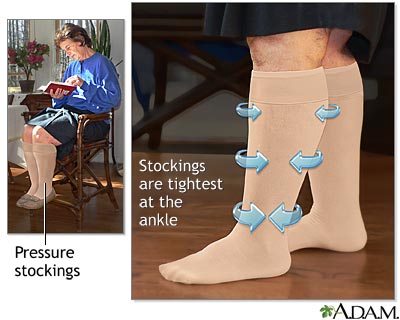Health Library
Deep vein thrombosis - discharge
DVT - discharge; Blood clot in the legs - discharge; Thromboembolism - discharge; Venous thromboembolism - deep vein thrombosis; Post-phlebitic syndrome - discharge; Post-thrombotic syndrome - discharge
You were treated for deep vein thrombosis (DVT). This is a condition in which a blood clot forms in a vein that is not on or near the surface of the body.
It mainly affects the large veins in the lower leg and thigh. The clot can block blood flow. If the clot breaks off and moves through the bloodstream, it can get stuck in the blood vessels in the lungs.
Images

I Would Like to Learn About:
Self-care
Wear the pressure stockings if prescribed by your healthcare provider. They may improve blood flow in your legs and may lower your risk for long-term complications and problems with blood clots.
- Avoid letting the stockings become very tight or wrinkled.
- If you use lotion on your legs, let it dry before you put the stockings on.
- Put powder on your legs to make it easier to put on the stockings.
- Wash the stockings each day with mild soap and water. Rinse and let them air dry.
- Be sure you have a second pair of stockings to wear while the other pair is being washed.
- If your stockings feel too tight, tell your provider. Do not just stop wearing them.
Your provider may give you medicine to thin your blood to help keep more clots from forming. The drugs warfarin (Coumadin), rivaroxaban (Xarelto), and apixaban (Eliquis) are examples of blood thinners. If you're prescribed a blood thinner:
- Take the medicine just the way your provider prescribed.
- Know what to do if you miss a dose.
- You may need to get blood tests often to make sure you are taking the right dose.
Ask your provider what exercises and other activities are safe for you to do.
Do not sit or lie down in the same position for long periods.
- Do not sit so that you put steady pressure on the back of your knee.
- Prop up your legs on a stool or chair if your legs swell when you sit.
If swelling is a problem, keep your legs resting above your heart. When sleeping, make the foot of the bed a few inches higher than the head of the bed.
When traveling:
- By car. Stop often, and get out and walk around for a few minutes.
- On a plane, bus, or train. Get up and walk around often.
- While sitting in a car, bus, plane, or train. Wiggle your toes, tighten and relax your calf muscles, and shift your position often.
Do not smoke. If you do, ask your provider for help quitting.
Drink at least 6 to 8 cups (1.5 to 2 liters) of liquid a day, if your provider says it is OK.
Use less salt.
- Do not add extra salt to your food.
- Do not eat canned foods and other processed foods that have a lot of salt.
- Read food labels to check the amount of salt (sodium) in foods. Ask your provider how much sodium is OK for you to eat each day.
When to Call the Doctor
Contact your provider if:
- Your skin looks pale, blue, or feels cold to touch
- You have more swelling in either or both of your legs
- You have fever or chills
- You are short of breath (it is hard to breathe)
- You have chest pain, especially if it gets worse upon taking a deep breath in
- You cough up blood
Related Information
Pulmonary embolusDeep vein thrombosis
Blood clots
Duplex ultrasound
Platelet count
Prothrombin time (PT)
Partial thromboplastin time (PTT)
Tips on how to quit smoking
Diabetes - preventing heart attack and stroke
Heart attack - discharge
References
Agency for Healthcare Research and Quality website. Your Guide to Preventing and Treating Blood Clots. www.ahrq.gov/patients-consumers/prevention/disease/bloodclots.html#. Updated August 2017. Accessed July 1, 2022.
Centers for Disease Control and Prevention website. Venous Thromboembolism (Blood Clots). www.cdc.gov/ncbddd/dvt/facts.html. Updated June 9, 2022. Accessed July 1, 2022.
Kearon C, Akl EA, Ornelas J, et al. Antithrombotic therapy for VTE disease: CHEST guideline and expert panel report. Chest. 2016;149(2):315-352. PMID: 26867832 pubmed.ncbi.nlm.nih.gov/26867832/.
Kline JA. Pulmonary embolism and deep vein thrombosis. In: Walls RM, Hockberger RS, Gausche-Hill M, eds. Rosen's Emergency Medicine: Concepts and Clinical Practice. 9th ed. Philadelphia, PA: Elsevier; 2018:chap 78.
BACK TO TOPReview Date: 1/25/2022
Reviewed By: Todd Gersten, MD, Hematology/Oncology, Florida Cancer Specialists & Research Institute, Wellington, FL. Review provided by VeriMed Healthcare Network. Also reviewed by David Zieve, MD, MHA, Medical Director, Brenda Conaway, Editorial Director, and the A.D.A.M. Editorial team.
 | A.D.A.M., Inc. is accredited by URAC, for Health Content Provider (www.urac.org). URAC's accreditation program is an independent audit to verify that A.D.A.M. follows rigorous standards of quality and accountability. A.D.A.M. is among the first to achieve this important distinction for online health information and services. Learn more about A.D.A.M.'s editorial policy, editorial process and privacy policy. A.D.A.M. is also a founding member of Hi-Ethics. This site complies with the HONcode standard for trustworthy health information: verify here. |
The information provided herein should not be used during any medical emergency or for the diagnosis or treatment of any medical condition. A licensed medical professional should be consulted for diagnosis and treatment of any and all medical conditions. Links to other sites are provided for information only -- they do not constitute endorsements of those other sites. © 1997- 2022 A.D.A.M., a business unit of Ebix, Inc. Any duplication or distribution of the information contained herein is strictly prohibited.
